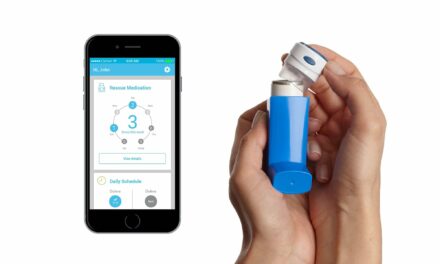Telemedicine provides health care practitioners with a way to treat asthma patients at home and improve their quality of life.

Videoconferencing for patient care or “telemedicine” is a 21st-century option for health care diagnosis and management. Originally developed by the National Aeronautics and Space Administration (NASA) in the early 1960s,1 videoconferencing uses a phone line to transmit both audio and video information via a video screen and speakers.2 Much like the Internet, telemedicine has joined computer and telephone technologies to create a new service. Telemedicine was produced by adding medical accessories such as magnifying lenses, stethoscopes, and blood pressure cuffs to existing videoconferencing programs.1
In telemedicine, a specific location is designated as the main station. Specialists, supervising physicians, or hospital facilities with specialized medical equipment are located at the main station. This station is then connected to remote stations.2 Information is gathered by a technician at the remote station and analyzed by a physician at the main station. The technician operates medical equipment that is connected to a two-way video screen and software program that transfers images and sounds to the main station. The physician at the main station interprets the information and can make a diagnosis, suggest treatment, or prescribe medication. Telemedicine allows people at two different locations to interact as if they are in the same room.
Benefits of Telemedicine
Many telemedicine stations are rurally located. Others are centrally located and are used to provide patients with access to medical care. Peter Leitner, president of Waterford Telemedicine Partners, New York, says, “Telemedicine is not just about connecting people in rural areas to health care. It’s really about improving access to health care. Inner city populations may be physically near a hospital but may be otherwise denied the access that telemedicine can provide.” Essentially, telemedicine can be used to service people who are a great distance from a health care facility, to provide supervised monitoring to all patients who have a chronic health concern, and to alleviate patients’ fears when a health problem occurs.
Due to the necessity of using high-tech equipment and the technical support training involved in operating telemedicine programs, you might assume that the implementation and maintenance costs are astronomical. However, early research suggests that telemedicine may in fact be as cost-effective or at least not significantly more expensive than traditional care. First, the continual deflation of computer equipment cost has made initial implementation more financially reasonable. Second, although there has been some reimbursement difficulties reported, government subsidy funding originating from the Rural Health Care Program, a development of the Telecommunications Act of 1996, has helped pay the phone bills for some rural telemedicine programs.3 Third, some health insurance providers are supplying clients with a prepaid telemedicine program insurance plan. These plans are especially convenient because the insured and the insurer do not have to worry about proving need for care to a third-party payor.1 Finally, there may be some savings in commute costs of the health care practitioners4 and decreased patient costs due to quick interventions and avoided hospitalizations and emergency department (ED) visits.5
Carol Meyer, MD, assistant professor of pediatrics and medicine at the Medical College of Georgia (MCG) and the Telemedicine Clinic in Association with MCG and Children’s Medical Services, Augusta, agrees and says, “At least locally, the number of ED visits for Medicaid patients has decreased. This, of course, has cut cost. With continuing care and education, ED visits and hospitalizations decrease.” It should be noted, however, that the data surrounding lowered patient costs due to avoided hospitalizations and ED visits are still in the information-gathering stage.1
Initially Diagnosing Asthma
After considering all the different aspects of telemedicine, the question arises as to how its use can benefit asthma care. Let us briefly consider what is involved in the initial asthma diagnosis and long-term asthma management so we can understand the benefits of telemedicine.
Several accompanying symptoms are involved in an asthmatic episode and are considered during the initial diagnosis. The initial diagnosis involves noting persistent symptoms of asthma such as productive or dry cough, chest discomfort, wheezing, and breathlessness.7 Symptom patterns should be discussed and identified as episodic, perennial, nocturnal, or continual. Severity based on the number of episodes per week should also be deliberated. Asthma triggers should be investigated. Triggers such as environmental allergens (dust mites, pet dander, pollen), exercise, occupational or recreational irritants (tobacco smoke, perfume, wood burning), humidity, certain foods, and particular drugs should also be considered. A full history of previous ED visits or hospitalizations for breathing-related problems should be noted. If a previous diagnosis of asthma was made, consideration should be given to the factors that prompted the diagnosis. The accuracy of the previous diagnosis should also be investigated. Current and past use of asthma medications and the effect of such medications should be taken into account. Telemedicine would be useful at this stage of gathering patient medical history and would save many rurally located people a long trip to their health care practitioner. In addition, people who have limited mobility due to financial constraints or physical ailments could also benefit from telemedicine reporting.
The initial diagnosis of asthma also involves a detailed physical examination and pulmonary function tests. During the physical examination, color and alertness should be noted.7 The pulmonary function tests should assess the vital signs of temperature, blood pressure, pulse, aspiration, chest auscultation, use of accessory muscles or intentional use of chest muscles other than the diaphragm, and measurement of peak flow rate or FEV1. While telemedicine can assess these signs via tele-stethoscope, tele-thermometer, and tele-blood pressure cuffs, it may be wise to conduct the initial physical examination in person.
A person-to-person visit may be better for initial diagnosis for two reasons. First, it would take a lot of time to train the remotely located telemedicine health care practitioner to conduct the physical examination normally performed by a physician. Since the time of the remotely located practitioner is usually taxed with the multiple aspects of running the telemedicine clinic, additional training may be best introduced as a future goal. Second, some health care practitioners believe that a more positive doctor/patient relationship can be formed when the initial consultation is personal.
Meyer believes that diagnosis via telemedicine would be appropriate with a properly trained technician. She also notes that the Health Care Financing Administration, which administers the Medicare program, will now pay for an examination that is performed by the nurse manipulating the instrument with the doctor visualizing and hearing the information. However, when there is an absence of a trained technician, Meyer supports a personal first contact. “I prefer my first contact to be in person. I think that you can build a better relationship that way. However, I believe that telemedicine is great for follow-up treatments. We do not replace the primary care physicians but supplement their work with patient education and more specialized treatment such as immunotherapy and gauge its outcome.”
Asthma Management
After the initial diagnosis, telemedicine can excel in the area of asthma care education for both patients and staff, asthma management, and medication compliance. All of these aspects of good asthma care can add up to a sense of patient security and relief. A telemedicine program can be used to teach self-monitoring to an individual patient, a group of patients, or a group of health care practitioners and family members. This education can prove to be invaluable as it may result in fewer ED visits and hospitalizations. Lahdensuo8 notes that “Seventy-five percent of admissions for asthma are avoidable, and potentially preventable factors are common in deaths from asthma. At least 40% of people with asthma do not react appropriately when their symptoms worsen, and more than 50% of patients admitted with acute asthma have had alarming symptoms for at least a week before admission.”
A good asthma management plan is often centered around patient education and is directed at maintaining control of asthma with the smallest amount of medication, thus minimizing the risk for adverse effects.7 Many Americans spend a lot of time in front of a TV screen and have thus become very comfortable with visual stimuli. Thus, telemedicine can become a highly effective, less threatening teaching tool. The health care team can teach the patient and the patient’s family about asthma and the use of an inhaler, holding chamber, or spacer divider. A dialogue discussing the role of medications can also freely occur.7 Some studies8 have found that patients and their families are actually more comfortable with telemedicine meetings as they believe they are on a more equal level and less patronized than they are in a physician’s office.
Since a more cooperative environment may result from a telemedicine conference, patients may be more likely to be active in developing and following their asthma self-management plan. A good program includes developing a proper rescue plan when a severe exacerbation occurs. Following proper environmental control measures to minimize exposure to known irritants is another positive step patients can take in order to control their asthma.7 Telemedicine can be a very useful communication tool in the development of a rescue plan and general asthma care guidelines.
Telemedicine can also be quite useful when reviewing and updating the self-management plan. A recent study10 performed by Joseph Finkelstein, MD, of the Department of Medical Informatics at Columbia University, New York City, followed 31 patients for 3 weeks to assess the value of data gathered from self-administered, spirometric tests. The data gathered from the tests were sent to their physicians via telemedicine. The subjects were low-income, inner-city patients who had no previous computer skills. At the end of the study, Finkelstein and his colleagues concluded that the data obtained from the self-administered tests were comparable to the results obtained from supervised spirometric tests. The majority of the patients also believed that operating the telemedicine devices was uncomplicated and felt safer when they were being monitored several times a day by a telemedicine program.
This sense of safety is achieved through continued care monitoring and ongoing follow-up treatments. These aspects are strong benefits of a telemedicine program. Leitner agrees with Meyer regarding follow-up treatments. “When it comes to asthma care and telemedicine, the real positive opportunity comes not in diagnosis, but in monitoring and maintaining long-term care to minimize co-morbidity, hospitalizations, and ED visits.”
In addition, telemedicine patients often are more likely to comply with asthma management.9 They generally accept more responsibility for their management because they are able to visualize what the doctor is seeing and can learn about asthma management in a nonthreatening environment. Treatment compliance coupled with more frequent check-ups can definitely improve the quality of care for asthma patients.
Improving Quality of Life
Telemedicine can also be used to improve the quality of life of asthma sufferers. By providing a way for patients to contact a health care practitioner at any time during an asthma attack or related asthma concern, telemedicine gives them a sense of peace and comfort.1 Strode et al4 note that by “using low-cost televideo equipment that runs over regular phone lines, providers are expanding the level of care and frequency of visits to the patient in the home at a much lower cost per visit.”
McDonald et al11 found that the quality of life of asthma patients can be significantly improved if subspecialty care is combined with an organized approach to asthma management. They based their findings on National Institutes of Health guidelines applied in a private practice setting. Since many aspects of telemedicine imitate aspects of a private practice office, it seems reasonable to conclude that the same combination of subspecialty care and an organized approach to asthma management could also improve the quality of life of telemedicine asthma patients.
Disadvantages
While telemedicine has opened many doors for asthma care, there are some disadvantages associated with telemedicine programs that should be noted. The first is cost. Again, the statistics used to perform a cost-benefit analysis are still in the information-gathering stage. The software upgrade costs and wear and replacement costs of hardware should also be included when cost is being considered. However, these costs seem to be less substantial as the market develops. Meyer commented on this aspect of telemedicine by saying that a hidden cost has “been a breakdown of the technology, but as the technology develops, the program should be easier to implement and maintain.”
Another issue of contention with telemedicine revolves around privacy. Transmission security is dependent on the type of technology that is being used to transfer the images. Interactive video and store and forward technologies that transfer images over cable and phone lines are relatively secure.4 Two-way satellite transmissions are not only more expensive but also less secure unless a scrambling device is used. While both modes of transmission can be made more secure for a fairly reasonable cost, accessibility may be compromised. Leitner points out that the confidentiality of medical records is not a new consideration. “In terms of telemedicine, ethical, privacy, and confidentiality issues are raised. However, I believe that these are not new questions. The ease of duplication of patient records has always been a concern. We as a society and as an industry need to be careful about ethical concerns.” By taking proper steps to ensure transmission security, a telemedicine program can operate ethically and ensure patient confidentiality. Leitner agrees by saying, “Overall, the benefits far outweigh the concerns and I believe it would be unethical to ignore the benefits of care that telemedicine offers.”
Software incompatibility and mailbox problems are other telemedicine concerns. Solving such problems may take as much time or longer than transferring the same information in the traditional paper form.12 As with any new “information age” technology, there are some valid concerns. However, such operating problems would likely be eliminated from the system in the initial days of installation or would be so infrequent as to not be sufficient grounds for dismantling the program.
Another difficulty in implementing and maintaining a telemedicine program has to do with health care practitioner compliance. Reports1,4 have noted physicians’ resistance to learning how to operate a telemedicine program. This reluctance to learn or suggest telemedicine as an alternate source for care may arise from a lack of time, a fear of the unknown computer-related technology, a suspected lack of financial reimbursement, or an inability or aversion to alter practice patterns.4 As with any new idea or program, there are the associated growing pains that should subside with time.
Conclusion
Considering all of the overall benefits and concerns surrounding a telemedicine program, it appears that telemedicine can be a positive program for continued asthma care. Adding applications such as continuing education for rurally located health care practitioners and administrative meetings for nationwide and statewide groups to the traditional clinical use can make a telemedicine program even more cost-effective.2,4 While initial implementation costs may be large, the number of skilled health care provider visits to asthma patients can increase without adding to treatment time.1,4,5 With more practitioner visits, more involved managed care patients, and more educated practitioners, the quality of care and life increases, and, after all, who can put a price on that?
Jennifer Vavra is a contributing writer for RT Magazine.
References
1. Myers CS. Tuning into patient care. RT, The Journal for Respiratory Care Practitioners. 1998;11(1):77-79, 118.
2. Myers CS. Long-distance learning. RT, The Journal for Respiratory Care Practitioners. 1999;12(4):89-92.
3. Hirschman C. Telemedicine subsidy isn’t reaching rural programs. American Medical News. 1999;42:19-20.
4. Strode SW, Gustke S, Allen A. Technical and clinical progress in telemedicine. JAMA. 1999;281:1066-1068.
5. Josey P, Gustke S. How to merge telemedicine with traditional clinical practice. Nursing Management. 1999;30:33-36.
6. Smith DW, Gips CD. Care of the Adult Patient: Medical-Surgical Nursing. Philadelphia: JB Lippincott Co; 1963.
7. Li J. Diagnosis and management of asthma. Postgraduate Medicine. 1999;105:191-202, 207.
8. Lahdensuo A. Guided self-management of asthma—how to do it. BMJ. 1999;319:759-760.
9. Daus C. Long-distance healing. RT, The Journal for Respiratory Care Practitioners. 1997;10(2):73-75.
10. Finkelstein J, Cabrera MR, Hripcsak G. Internet-based home asthma telemonitoring: can patients handle the technology? Chest. 2000;117:148-155.
11. McDonald RJ, Cosmic M, Berchou K. Effect of an asthma management program and subspecialty care on asthma outcomes and quality of life. Chest. 1999;116:S293.
12. Crossley N. Glorious technicolor? It’s not that black and white. Nursing Times. 1999;95:44-46.









